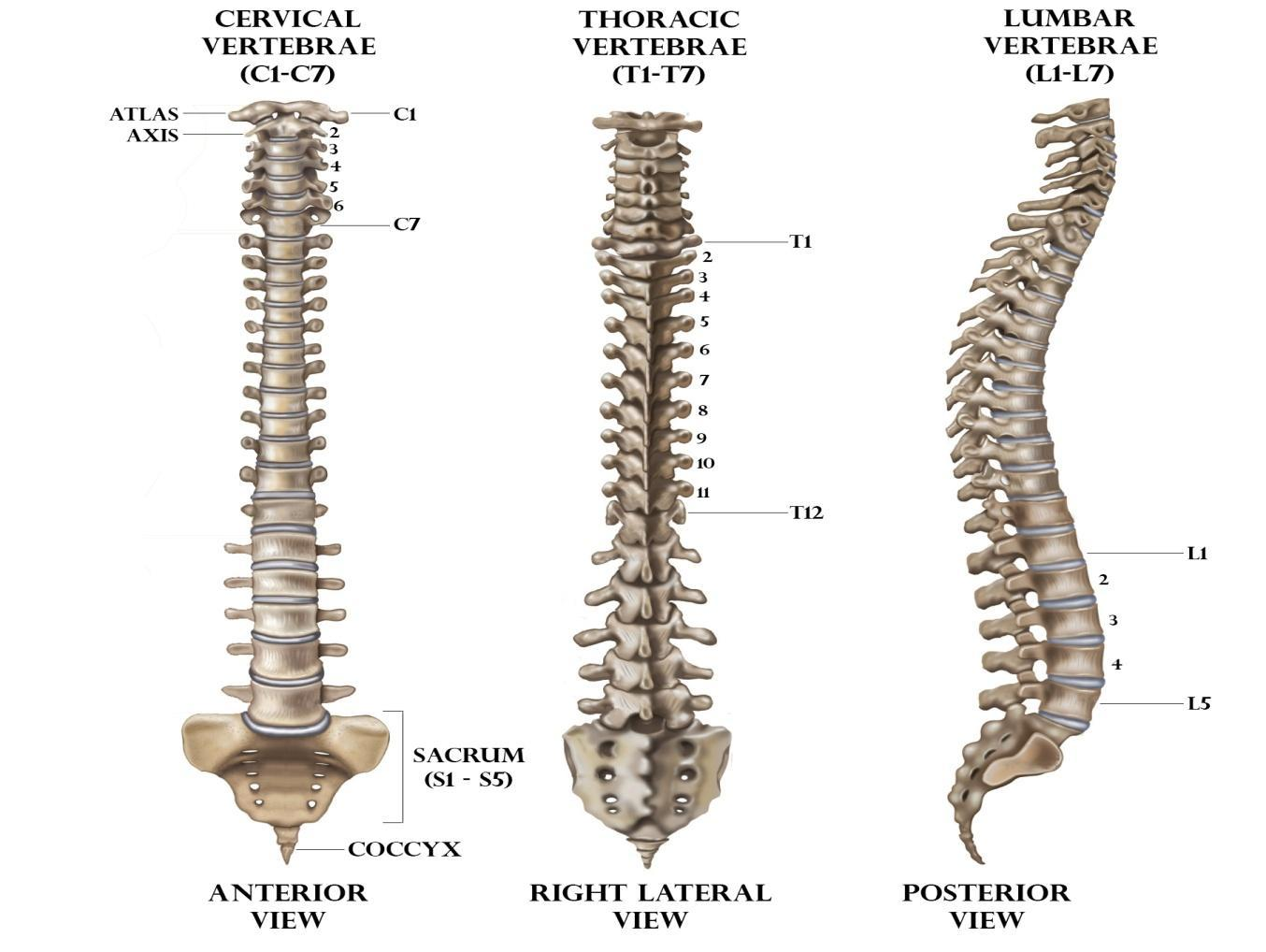
The backbone is not a single bone. It is made of _______ bones
(a) 33
(b) 34
(c) 35
(d) 36
Answer
500.4k+ views
Hint: The vertebral column is not made of a single bone since it is difficult to bend one single bone. The backbone consists of small bones known as the vertebrae. The spinal cord comprises 7 cervical, 12 thoracic, 5 lumbar, 5 sacral, and 4 coccygeal bones.
Complete answer:
The vertebral column (Backbone) has a total of 33 bones. The vertebrae are divided into regions such as cervical, thoracic, lumbar, sacrum, and coccyx. Had it been made of a single bone, the body would not have been able to display the motion. Therefore it is the sequence of vertebrae running from the cranium to the coccyx. These bones make the spine flexible.
Cervical (neck): the principal purpose of the cervical spine is to bear the head weight. The seven cervical vertebrae are C1 to C7. Due to two specialized vertebrae that attach to the skull, the neck has the greatest range of motion.
Thoracic (mid-back): Supporting the rib cage and shielding the heart and lungs is the main feature of the thoracic spine. The numbering of the twelve thoracic vertebrae is T1 to T12. There is a restricted range of motion within the thoracic spine.
Lumbar (low back): The lumbar spine's main purpose is to support body weight. The five lumbar vertebrae are numbered from L1 to L5. To absorb the stress of lifting and carrying heavy objects these vertebrae are much larger.
Sacrum: The main purpose of the sacrum is to link the spine with the hip (iliac) bones. Five sacral vertebrae are fused. They form a ring together with the iliac bones named the pelvic girdle.
The coccyx area: The fused four coccyx or tailbone bones provide support for pelvic floor ligaments and muscles.

So, the correct answer is, ‘33’.
Note: The human backbone strengthens our body and assists in movement. The backbone structure helps us to bend, crouch, stand and lie down on the ground. The movement is facilitated by the vertebral units. Only the top 24 bones are mobile; the sacrum and coccyx vertebrae are fused. In each area, the vertebrae have unique features that help them perform their principal functions.
Complete answer:
The vertebral column (Backbone) has a total of 33 bones. The vertebrae are divided into regions such as cervical, thoracic, lumbar, sacrum, and coccyx. Had it been made of a single bone, the body would not have been able to display the motion. Therefore it is the sequence of vertebrae running from the cranium to the coccyx. These bones make the spine flexible.
Cervical (neck): the principal purpose of the cervical spine is to bear the head weight. The seven cervical vertebrae are C1 to C7. Due to two specialized vertebrae that attach to the skull, the neck has the greatest range of motion.
Thoracic (mid-back): Supporting the rib cage and shielding the heart and lungs is the main feature of the thoracic spine. The numbering of the twelve thoracic vertebrae is T1 to T12. There is a restricted range of motion within the thoracic spine.
Lumbar (low back): The lumbar spine's main purpose is to support body weight. The five lumbar vertebrae are numbered from L1 to L5. To absorb the stress of lifting and carrying heavy objects these vertebrae are much larger.
Sacrum: The main purpose of the sacrum is to link the spine with the hip (iliac) bones. Five sacral vertebrae are fused. They form a ring together with the iliac bones named the pelvic girdle.
The coccyx area: The fused four coccyx or tailbone bones provide support for pelvic floor ligaments and muscles.

So, the correct answer is, ‘33’.
Note: The human backbone strengthens our body and assists in movement. The backbone structure helps us to bend, crouch, stand and lie down on the ground. The movement is facilitated by the vertebral units. Only the top 24 bones are mobile; the sacrum and coccyx vertebrae are fused. In each area, the vertebrae have unique features that help them perform their principal functions.
Recently Updated Pages
Master Class 11 Economics: Engaging Questions & Answers for Success

Master Class 11 Business Studies: Engaging Questions & Answers for Success

Master Class 11 Accountancy: Engaging Questions & Answers for Success

Master Class 11 English: Engaging Questions & Answers for Success

Master Class 11 Computer Science: Engaging Questions & Answers for Success

Master Class 11 Maths: Engaging Questions & Answers for Success

Trending doubts
State and prove Bernoullis theorem class 11 physics CBSE

1 ton equals to A 100 kg B 1000 kg C 10 kg D 10000 class 11 physics CBSE

State the laws of reflection of light

One Metric ton is equal to kg A 10000 B 1000 C 100 class 11 physics CBSE

1 Quintal is equal to a 110 kg b 10 kg c 100kg d 1000 class 11 physics CBSE

Difference Between Prokaryotic Cells and Eukaryotic Cells




